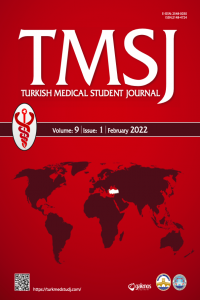THE FOURTH HORSEMAN OF 21ST CENTURY: COVID-19 PANDEMIC
THE FOURTH HORSEMAN OF 21ST CENTURY: COVID-19 PANDEMIC
Covid-19, Sars-Cov-2 pandemic, healthcare,
___
- 1. Moris D, Folkers GK, Anthony F. What is a pandemic? The Jour- nal of Infectious Diseases 2009;200(7):1018-21.
- 2. IA Khan. Plague: The dreadful visitation occupying the human mind for centuries. Trans R Soc Trop Med Hyg 2004;98(5):270-7.
- 3. Glezen WP. Emerging infections: Pandemic influenza. Epidemi- ologic Reviews 1996;18(1):64-76.
- 4. C Thèves, P Biagini, E Crubézy. The rediscovery of smallpox. Clin Microbiol Infect 2014;20(3):210-8.
- 5. Pandemic Influenza Preparedness and Response: A WHO Guid- ance Document. Geneva: World Health Organization; 2009.
- 6. Jaacks LM, Vandevijvere S, Pan A et al. The obesity transi- tion: Stages of the global epidemic. Lancet Diabetes Endocrinol 2019;7(3):231-40.
- 7. Institute of Medicine (US) Forum on Microbial Threats. Glob- al climate change and extreme weather events: Understanding the contributions to infectious disease emergence: Workshop summa- ry. Washington (DC) National Academies Press (US); 2008.
- 8. Garnett GP, Lewis JJC. The impact of population growth on the epidemiology and evolution of infectious diseases. In: Caraël M, Glynn JR, editors. HIV, Resurgent Infections and Population Change in Africa. International Studies in Population. Springer, Dordrecht; 2007:7.p. 27-41.
- 9. Greene WC. A history of AIDS: Looking back to see ahead. Eu- ropean Journal of Immunology 2007;37:94-102.
- 10. Anderson RM, Fraser C, Ghani AC et al. Epidemiology, trans- mission dynamics and control of SARS: the 2002-2003 epidemic. Philos Trans R Soc Lond B Biol Sci 2004;359(1447):1091-105.
- 11. Musso D, Gubler DJ. Zika virus. Clin Microbiol Rev 2016;29(3):487-524.
- 12. Mackay IM, Arden KE. MERS coronavirus: Diagnostics, epide- miology and transmission. Virol J 2015;12:222.
- 13. Li W, Moore M, Vasilieva N et al. Angiotensin-converting en- zyme 2 is a functional receptor for the SARS coronavirus. Nature 2020;426:450–4.
- 14. Callaway E. The coronavirus is mutating — does it matter? Na- ture 2020;585:174-7.
- 15. de Wilde AH, Snijder EJ, Kikkert M et al. Host Factors in Coro- navirus Replication. Curr Top Microbiol Immunol 2018;419:1-42.
- 16. Guo YR, Cao QD, Hong ZS et al. The origin, transmission and clinical therapies on coronavirus disease 2019 (COVID-19) out- break - an update on the status. Mil Med Res 2020;7(1):11.
- 17. Le Quéré C, Jackson RB, Jones MW et al. Temporary reduction in daily global CO2 emissions during the COVID-19 forced con- finement. Nat Clim Chang 2020;10:647–53.
- 18. Cullmann J, Dilley Maxx, Egerton P et al. 2020 State of climate services. WMO 2020:1-47.
- 19. Friedlingstein P, Jones MW, O’Sullivan M et al. Global Carbon Budget 2019. Earth Sys Sci Data 2019;11:1783–838.
- 20. Peters GP, Andrew RM, Canadell JG et al. Carbon dioxide emis- sions continue to grow amidst slowly emerging climate policies. Nat Clim Change 2020;10:3–6.
- 21. Rosen GE, Smith, KF. Summarizing the Evidence on the inter- national trade in illegal wildlife. EcoHealth 2010;7(1):24-32.
- 22. Karesh WB, Cook RA, Bennett EL et al. Wildlife trade and glob- al disease emergence. Emerg Infect Dis 2005;11(7):1000-2.
- 23. Berger D. A brief history of medical diagnosis and the birth of the clinical laboratory. Part 1-Ancient times through the 19th cen- tury. Med Lab Obs 1999;31(7):28-30, 32, 34-40.
- 24. Bettmann OL, Hench PS. A Pictorial History of Medicine. 1st ed. Charles C Thomas Pub Ltd; 1956.
- 25. Cunningham A, Williams P. The Laboratory Revolution in Med- icine. Cambridge, Great Britain: Cambridge University Press; 1992.
- 26. Kvedar J, Coye MJ, Everett W. Connected health: A review of technologies and strategies to improve patient care with telemedi- cine and telehealth. Health Affairs 2014;33:194-9.
- 27. Gonçalves-Bradley DC, Maria AR, Ricci-Cabello I et al. Mobile technologies to support healthcare provider to healthcare provider communication and management of care. Cochrane Database Syst Rev 2020;8(8):1-104.
- 28. Hollander JE, Carr BG. Virtually perfect? telemedicine for Covid-19. N Engl J Med 2020;382:1679-81.
- 29. Chaet D, Clearfield R, Sabin JE et al. Ethical practice in tele- health and telemedicine. J Gen Intern Med 2017;32(10):1136-40.
- ISSN: 2148-4724
- Başlangıç: 2014
- Yayıncı: Trakya Üniversitesi
THE EFFECT OF 5-FU AND RUXOLITINIB ON MITOCHONDRIAL APOPTOSIS IN GLIOBLASTOMA U87 CELL LINE
Gonca AKSU, Oğuzhan DOĞANLAR, Zeynep Banu DOĞANLAR
DISTANCE EDUCATION IN MEDICAL SCHOOLS: THE EXPERIENCE AND OPINIONS OF ACADEMICIANS AND STUDENTS
Hilal Sena ÇİFCİBAŞI, Berkay KEF, Irmak İrem ÖZYİĞİT, Sezin SAYIN, Aslı GÖZTEPE, Selis Gülseven GÜVEN, Serkan ATICI
THE FOURTH HORSEMAN OF 21ST CENTURY: COVID-19 PANDEMIC
İnci KADRİBEY, Fatih Erkan AKAY
INVESTIGATION OF THE PARAMETERS THAT MAY PREDICT HEMODIALYSIS FREQUENCY
Gökhan KIRAL, Alperen Taha CERTEL, Irmak İrem ÖZYİĞİT, Begüm SÖYLEYİCİ, Güray AYGÜN, Cenk GÖKALP
Elif CENGİZ, Fevzi Oktay ŞİŞMAN, Beliz KOÇYİĞİT, Mehmet Gürkan ARIKAN, Tevfik AKTOZ
PATHOPHYSIOLOGY, CLINICAL FEATURES AND TREATMENT OF MICROVASCULAR ANGINA: A REVIEW
Hasan Selçuk ÖZKAN, Meral KAYIKÇIOĞLU
MYOCARDIAL INFARCTION DIAGNOSIS AND CARDIAC TROPONINS
Berra KURTOĞLU, Burcu ERKILIÇ, Dilay Yağmur GÜRSEL, Gülsüm ARSLAN, Ogün BACAKSIZOĞLU, Pınar ALTUNDAL, Selin KARA, Yasemin ARDIÇOĞLU
JUVENILE POLYP FROM SYMPTOM TO DIAGNOSIS AND THE ROLE OF ULTRASONOGRAPHY: A CASE REPORT
